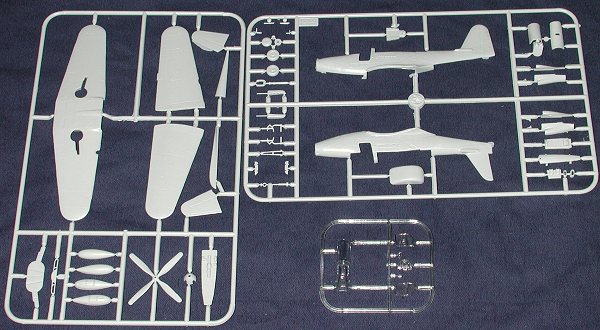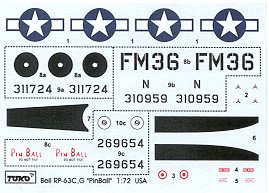
|
KIT: |
Toko 1/72 RP-63G 'Pinball' |
|
KIT # |
114 |
|
PRICE: |
$7.98 |
|
DECALS: |
Two (three) aircraft |
|
REVIEW & |
|
|
NOTES: |
|

|
HISTORY |
Bell's P-39 Airacobra was a revolutionary fighter for the USAAC. It was heavily armed with a nose mounted 37 mm cannon, it had tricycle landing gear, it had a door to enter the cockpit, and most of all, it was mid-engined with the engine behind the cockpit. The prototype was a superb plane; its turbocharged engine and light weight (light because it had a pathetic internal fuel capacity) made it a real pocket rocket.
Reality sunk in when the Army decided it didn't want expensive turbocharging and the addition of military stuff like armor plating and radios increased the weight, it went from a rocket to a plane that wasn't quite so quick. It still had a very good rate of climb, but the lack of turbocharging meant that it ran out of steam about 15-17,000 feet and getting to 20,000 feet took forever. However, war was coming and the plane was capable at low levels so the Army bought them.
In US service, the plane did well, but again was a pig at altitude and altitude performance was really needed. So they pawned the plane off on the Brits. They didn't want it for many of the same reasons. Then they tried the Russians. They loved it. Big gun, good low level performance and easy to maintain. Many Soviet pilots were aces in the P-39.
Then came the P-63. It was everything that Bell wanted the P-39 to be. Thanks to its new laminar flow wing and more powerful engine, it was a great plane. Problem was that the USAAF already had a great plane by this time in the P-51 and couldn't see confusing the supply system by large production of the P-63. However, the Soviets were thrilled. Here was a better Airacobra! Most of the P-63 production went to them. Whether they were actually used in combat is unknown as little information about King Cobra operations in wartime Russia are known to the West.
Back in the States, the KingCobra was used in various training commands and a fighter trainer. They were also used as live targets for training bomber gunners. The planes were armored and had many of the usual vents and holes either covered or heavily screened. Gunner trainees used frangible bullets that would break on impact and not punch holes in the plane. The planes were painted orange or orange/yellow to make them easy to see (too bad the Germans wouldn't be so cooperative) and eventually fitted with lights that would come on when the plane was hit. I can imagine that flying these planes was quite an experience. The armor had to make them rather sluggish and being shot at couldn't have been a ton of fun!
|
THE KIT |

P-63 models have not been all over the place. Frankly, until MPM did theirs several years ago, your only real choice in injected plastic for the 1/72 modeler was a truly ancient and rather crude Aoshima kit. However, it was recognizable as the P-63 when done. Naturally your editor never let crudity stand in his way and has actually reviewed this kit.
Toko's kit is not that old, and is probably the best 1/72 version of the P-63 around. It is nicely detailed with engraved panel lines and rivets. The parts are flash-free with no sink marks where you'll see them and no pesky ejector pin marks that will be visible on the finished kit.
As you might expect, the only difference between this kit and the other P-63 variants is the box art, decals and painting guide. You get all the extra pieces for the other P-63 types so could do one of the others if you so desired. Down side is that there are not really that many 1/72 P-63 aftermarket sheets around to use. Optional parts on the kit are underwing drop/fuel tanks and cannon pods, which are not used on this version.
Instructions are more than adequate with several construction steps, a parts
chart to show what isn't used on the RP-63G, and a decal and coloring guide. All
colors are given in generic terms and show Humbrol paint codes. The color chart
would have you paint the plane overall Neutral Grey, but I can tell you that it
just isn't so. Neither is the Matte Blaze. The planes were an orangeish yellow
color. You'll probably have to do a bit of mixing by adding a touch of red or
orange to your favorite yellow paint. Frankly, the color police won't be beating
your door down if you don't get the shade perfect!

The decals are for three different aircraft, at least one of them being a P-63C and not shown in the instructions or box art. The plane shown in the instructions is repeated on the back of the box and the second plane is the box art plane. I can guarantee you that the decals will not be able to overcome the brilliant color and that you will have bleed-through of the white parts. It is inevitable!
Though I did not use it for this preview, there is an 'In Action' title on the
P-39/P-63 that will be a helpful reference when building the kit.
|
CONCLUSIONS |
The kit looks as if it will be a relatively straight-forward build with no real surprises. It will be interesting to see if the cockpit doors fit as those on the Academy P-39 didn't. The subject is interesting and colorful so should make a very nice addition to your collection.
Review kit courtesy of my kit collection.
If you would like your product reviewed fairly and quickly by a site that has over 100,000 visitors a month, please contact me or see other details in the Note to Contributors.